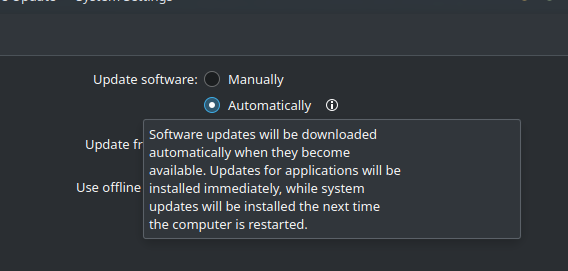#1 is just not being the default for 99% of devices. If someone gets a new computer, why would they go through the effort of installing a new os when the one it comes with works fine? Hell, I bet at least 50% of people in the market for a pc don’t even know what an OS is.
Agreed. Android and chrome os are used happily by 10s of millions without any idea it’s a Linux distro
I bet if small, cheap netbooks came out running mint or fedora or something people wouldn’t even or know or care that it was Linux.
In middle school I had a USB drive with Linux Mint installed on it which I was using on school PCs. We only used those PCs for internet browsing and office. Not a single soul noticed it wasn’t Windows. Teacher only noticed 2 differences, “You have different version of Office installed here.” and also gave me a note for “Changing wallpaper” which was strictly prohibited for some reason.
which was strictly prohibited
It was probably due to some goober like me changing it to Scarlett Johansson’s bikini pics.
So… the Steamdeck?
Absolutely. In fact i think everyone is hoping steam os will be the distro to make the big push onto desktop because of the gaming and another just works kind of interface
…the steamdeck isn’t a netbook.
Which actually means Linux is being successfully adopted by the general public in a similar way to windows as a general use system that doesn’t require a lot of technical knowledge.
Fully customizable distress will never be popular with the general public. They want systems that just do the general stuff and have it work automatically.
Of course they know what an OS is. There’s only two of them: Apple and Microsoft.
I bet at least 50% of people in the market for a pc don’t even know what an OS is.
70%*
New user: I have a problem 😊
Everyone:👍
- are you on xorg or wayland?
- pulseaudio or pipewire?
- what WM/DE are you using?
- amd or nvidia?
- what distro?
- systemd?
New user: Nevermind 😮💨
if a new user is using a distro that doesn’t use systemd they fell for a meme
if a new user is using a distro that doesn’t use systemd they fell for a meme
Or they hate fridge art like systemd and are on something like PCLinuxOS or Alpine.
That’s what I mean though, why would a new user be running alpine as a desktop os?
That would be me: My hardware at the time was crap so I couldn’t use the usual mint, ubuntu, etc and I was gonna use debian but I couldn’t find the x86 download button, so after a bunch of messing about with distros like puppy and #!++, I settled on alpine for a bit. I now have decent hardware and use fedora.
At this point, my biggest dream is that these ‘new user’ distros used only Wayland, Pipewire, Systemd and Flatpaks simply to simplify things. Hopefully we’re less than 2024 away from NoVideo Wayland support.
Also as soon as XFCE releases their Wayland support, that soon it’ll become the most famous DE choice of Mint.
What I am really happy is to see how well supported Pipewire already is. Pipewire has never showed any problem in the new installs for me.
So … basically Pop!_OS.
That’s what I’m using now, and it’s what I’d recommend for most desktop users. I’ve been using Linux systems on-and-off since before kernel version 1.0: Slackware, then Debian, then Ubuntu, then Mint, then Pop.
(Admittedly, my use cases are pretty simple: a terminal, a browser, Signal, VLC, and Steam.)
Pretty much. Pop is my go-to recommendation for pretty much anyone these days. It’s so well polished and just easy.
This PopOs ?
The problem with that is most major distros market themselves as “new user” distros to some extent though. Noob-friendly, out-of-the-box, easy, etc are all distro-marketing buzz-words that mean nothing.
You can’t expect them to only use Wayland, Pipewire, Systemd, and Flatpaks because that dream requires every distro to use Wayland, Pipewire, Systemd, and Flatpaks, which will never be reality.
Most distros will probably eventually adopt these tools, but there won’t be a sudden shift. It will be gradual.
Well, for Pipewire it’s the apps which needs to adjust at this point. Only thing missing currently is the Wayland but it’s coming. Making Linux less fragmented (read: confusing), the more new users will give a try.
pipewire seems ready for primetime but I’m more dubious about Wayland. For instance KDE appears to still be a bit flaky and sway still works poorly under Nvidia and will never have proper mixed DPI for xwayland apps. Still seems like a tradeoff vs X which doesn’t require a compromise. XFCE is roughly 10% of Mint users. Mint users are unlikely to switch because of wayland support
Systemd
Fridge art. Fuck, they MAYBE have nfsroot working. MAYBE. After a decade of fucking around, when it was available for ages. The number of bags on the side of lennart’s piece of crap, just to reinvent the wheels we had before, is absolutely ridiculous.
and Flatpaks
… break single source of truth for as-built information and current software manifest. This kills validation, which dissolves certainty on consistency, then repeatability. And given the state of the software load exported to management tools is NOT the flatpak source of truth, you now have a false negative on the ‘installation’ of a flatpak resource when checking it via management.
Oh. That needs to be on the interview questions.
Gonna be honest with you I’m an intermediate user and understood jack shit of what you just said. A beginner and average user would have probably been scared off by Linux by this point rewding this.
If I understood the funny words magic man correctly, he is complaining that flatpaks don’t come from a single trusted source and may become a vector for malware, unlike official distro repositories. Still, that was a very technobabble way of saying it.
That sounds to me like OP is trying to seem smarter than he is then
A beginner and average user would have probably been scared off by Linux by this point rewding this.
Maybe thats what he/she was trying to achieve.
Doing tech support, I encountered this attitude. People like that are nearly impossible to help. “Why can’t you just fix it!” The true answer never given is that your problem is probably something stupid you are doing, like trying to make a phone call by physically shoving the phone entirely up your asshole, and until I run through some common problems and ask some questions, I won’t be able to tell you to have your significant other get the salad tongs and pull it out of your rear and then go over “dialing.”
People mostly need to be willing to gather detailed system info with Inxi and share it.
No. That’s the support job to figure out the problem of the user. It is not the user’s job to figure out the support problems.
I work in support, so I know what I’m talking about. Unfortunately most computer guys are elitist assholes who can’t understand a user doesn’t have their knowledge or even the will to understand why this shitty tech is not working.
Free open source software projects you don’t pay for don’t have paid support. If you talk to a fellow user it IS your job to figure out your problem. if you don’t have the will to understand anything you ought to buy a support contract.
So you want them to provide answers by using magic? If you seek support for any software, open source or otherwise, you’ll need to tell them version, build number etc. Why do you think Linux will be any different?
Because people can already barely provide this level of information for a Windows device. Most of these words look like technobabble to non-tech-enthusiasts
Of course the words will be different. They aren’t hard words. And they can be answered very easily. In fact, most forums ask to include an output of something like
inxi -Fazywith every question, thus eliminating the need for all of these things.For more niche problems, people might ask for more specific information. But most of the time, they’ll tell you exactly what to run to get that information.
You know what’s the Windows alternative for this? Most of the time, nothing. You need to reinstall Windows. Mac is similar, except you need to have it replaced. You actually CAN repair Linux. That’s the difference.
- Isn’t pre-installed on well known machines by well known brands.
- Popular applications (whether productivity, creativity, or games) do not work out of the box that people want. It doesn’t matter that alternatives exist, or that you can use things like Wine. If it’s more than just click the icon, it’s too much.
- If things cannot be done purely through touch / the mouse, it is too hard for most people.
If things cannot be done purely through touch / the mouse, it is too hard for most people.
100%. Even as a power-user (understatement) who overwhelmingly prefers keyboard input to control things when I’m “gettin’ stuff done”, I will sometimes miss the general consideration level of Windows’ input handling when it comes to mouse and especially touch. Mouse is pretty damn good these days on Linux, but touch…
Touch is abysmal. A ton of modern laptops have touchscreens, or are actually 2-in-1s that fold into tablets, etc, and the support is just barely there, if at all. I’m not talking about driver support - this is often fairly acceptable. My laptop’s touch and pen interface worked right out of the box… technically. But KDE Plasma 5 with Wayland- an allegedly very modern desktop stack- is not pleasant when I fold into tablet mode.
The sole (seriously, I’ve looked) Wayland on-screen-keyboard, Maliit, is just terrible. No settings of any kind (there is a settings button! it is not wired to anything, it does nothing), no language options, no layout options (the default layout is abysmal and lacks any ‘functional’ keys like arrows, pgup/dn, home/end, delete, F keys, tab, etc), and most egregiously, it resists being manually summoned which is terrible because it does not summon itself at appropriate times. Firefox is invisible to it. KRunner is invisible to it. The application search bar is invisible to it. It will happily pop up when I tap into Konsole, but it’s totally useless as it is completely devoid of vital keys. Touch on Wayland is absolutely pointless.
Of course, there is a diverse ecosystem of virtual keyboards and such on Xorg! However, Xorg performance across all applications is typically abysmal (below 1FPS) if the screen is rotated at all. This is evidently a well known issue that I doubt will ever be fixed.
In the spirit of Open Source Software, and knowing that simply complaining loudly has little benefit for anyone, I have at several times channeled my frustration towards developing a reasonable Wayland virtual keyboard, but it’s a daunting project fraught with serious problems and I have little free-time, so it’s barely left its infancy in my dev folder, and in the meanwhile I reluctantly just flip my keyboard back around on the couch with a sigh, briefly envious of my friend’s extremely-touch-capable Windows 2-in-1.
I echo your frustrations with Maalit. I am running Arch on my Surface Pro 7 and very frequently I have to snap in the keyboard just to get myself out of a situation where touch doesn’t work. Maalit also has this bug where it will push and resize windows as if it was visible even though it is hidden.
Regarding the Firefox issue, it helps if you enable it’s Wayland backend by passing MOZ_ENABLE_WAYLAND=1 to it. Maalit should properly pop whenever you tap on a text box.
MOZ_ENABLE_WAYLAND=1
Thank you - I was already aware of this, actually, but I choose to leave it disabled because when this is set, touchscreen drag-scrolling of webpages breaks and it selects text as though it were a mouse click-drag instead. As it turns out, I barely use Maliit anyway because of its other deficiencies, but I definitely touch-scroll my browser a lot, even in laptop mode. A generally disappointing dilemma!
I also had this problem where touch scrolling on Firefox selects text instead (on ubuntu). It does however work OOTB for me on fedora, so it’s the main distro on that machine.
Weird! Touch scrolling actually improves for me with the Wayland backend so that’s an odd issue indeed! There’s gotta be a trick to it, but I am unsure of what that is at the moment.
GNOME has amazing touchscreen gestures, and afaik comes with it’s own virtual keyboard
I have been tempted by GNOME several times, but I disagree with some of their design choices and find them a bit frustrating. I feel that it’s fairly strongly-opinionated software. The benefits, of course, are obvious: internal consistency that leads to a higher quality experience. But, only if you buy-in to some overarching design philosophy. That’s one of the reasons I left Windows! I also have a suite of Kwin scripts that make my life a lot easier, so it’s pretty hard to leave Plasma at this point.
Still, that keyboard has tempted me a lot nonetheless…
Me too. I love the look of Adwaita, but some of their choices I can’t get past, like not having a system tray. I’m really excited for Cosmic, it looks like it will blend the styling of GNOME with much of KDE’s customization!
COSMIC is now on my radar, thank you. It looks very intriguing.
At this point I’m just glad I migrated to GNU/Linux way before touch input was a common thing. I never experienced it on Windows and the only way I experienced it on GNU/Linux is with it behaving like simple mouse clicks. I literally have no idea what else to expect, so I expect nothing and I don’t get disappointed.
Using touch on Windows has definitely set my expectations much higher than the reality on Linux right now, so this is a good call! You won’t know what you’re missing, so it’s not going to bug you. I kind of wish I could return to this blissful ignorance. I have another 2-in-1 with Windows 11 on it in the house and anytime I look at it to keep it patched up and fix issues for its user, it reminds me very effectively of how far behind my 2-in-1 is with touchscreen interactions :(
I agree with the touchscreen thing-- I have one of those foldy-aroundy 2-in-1 laptops, and the only way I’ve been able to get touch to work properly (as in not like a mouse) is gnome wayland. Kde wayland’s fine too, but like you said there’s no included keyboard whereas gnome has one built-in. Also another wayland osk you could try is wvkbd (tho I’ve never used it beyond “hey what’s this”).
While this is true, if someone goes to a shop and buys a “PC”, it will have Windows 100% of the time.
You have to look to get Linux preinstalled on stuff, or pick the choice yourself. People buying PCs aren’t picking Windows, it’s just what comes with them.
Preinstalled.
Like, were nerds and we fuck with our computers n stuff. But most people are lucky to know what a power cord is.
Honestly if Linux with a good DE like KDE or Cinnamon was already on their PC at boot they would figure it out. Most people just use a web browser anyways.
This is definitely how I feel as well. None of the other shit matters unless it comes already on the machine. Even then, it absolutely has to be rock solid stable long term for it to be comparative. Of course that’s asking a lot, considering people still take their PCs into geek squad or wherever else when something goes wrong (or their printer won’t connect).
This always reminds me of the Dell XPS option of having Ubuntu installed but of course that’s far away from “Microsoft literally pays us to sell their shit”. So, until that - or some type of adoption occurs on a B&M level/online-storefront - it’s going to be pretty “voluntary” in terms of adoption. It’s just comparatively so much more work in the layman’s sense.
It’s in a weird way the same with cars. It’s been statistically proven that most people specifically won’t go out of their way to get a simple utility pickup truck. They buy the big fuck you truck because that’s what the dealerships have. It’s the same thing with kids going to college and the parents taking them to buy a laptop for class. My point is that it’s far more easier to just use what you get than try to rehash it. Maybe you don’t even know that’s a possibility so you just settle. Of course this isn’t the only issue, but imo the largest determining factor. IBM had businesses sucking from the teet since computers dropped, and we still deal with the ramifications.
I have my dad on Mint for years. Setup browser and email program and told him to click on that little shield and do updates when it’s there. You can set the shield icon to only appear in case of updates. I sometimes have to update between versions. I think he is still on 21.0 and now 21.2 is out already.
I have put my dad on Kubuntu. Don’t like anything *buntu, personally, but I have to admit it’s quite stable and with sane defaults. He hasn’t complained ever since and support calls dropped considerably. He spends most of the time in Firefox anyways, where I’ve added ublock.
The problem with Windows was, he’d occasionally browse the web with Edge by mistake (or because MS forces it down your throat), and as soon as an 80+ y.o. browses the web without ad blocking, getting a virus is just a matter of time.
All this is to say that I agree with the fact that preinstalled is key. I wish that more effort was focused on fewer distros and I feel that so much talent and energies are being lost in marginal projects.
But many people do this for passion and it’s of course their choice to decide where to contribute, or whether to spin up a brand new distro entirely, can’t judge them for that. I’m just observing that those energies could be better used to smoothen some rough edges on more popular distros to make them even more appealing to OEMs and convince them to ship those on their hardware.
Most people buy computers with the OS already installed and would get just as lost trying to install MacOS or Windows.
This is the correct answer. If Linux was pre-installed, most problems would vanish. My Linux computers are far, far more stable than windows once they run.
- Self updating without user interaction per default.
- Better support of codecs and drivers.
Linux does have better codecs and drivers than Windows for some stuff (Bluetooth for example), but it has worse codecs and drivers for some important proprietary hardware stuff (Nvidia for example)
deleted by creator
See, that paragraph alone is too much for the majority of non-Linux users.
i believe fedora has this by default

I’m old. I can use stone age computers. The real barrier is the language. If you can’t explain things to me (that knows how to do shit) in terms I’ve heard before, basically nobody outside of power user, niche users, or software engineers will ever try an OS that you have to learn a new language for just to ask a question. Thank you, that is my longest run-on sentence, and I’m a scientist.
Self updating without user interaction per default.
I think that this is a terrible idea, until a clear boundary is set between applications that can or cannot break the system. Updating flatpaks automatically might be fine, but updating everything is simply a recipe for disaster.
Linux really isn’t ideal for anyone who isn’t already a tech enthusiast on some level. I recently did a fresh install of Kubuntu and after about a week, it prompted me that there were updates, so I clicked the notification and ran the updates, after which my BIOS could no longer detect the UEFI partition. I had to use a live usb to chroot into the system and repair it, as well as update grub, in order to fix it.
It’s fixable, but this is not something anyone who doesn’t already know what they’re doing can fix. I’ve had auto updates in the past put me on boot-loops thanks to nvidia drivers, etc.
This kind of thing needs to almost never happen for linux to be friendly for those who just want their computer to work without any technical understanding. This, honestly though, can’t happen because of the nature of distros, you can’t ever make guarantees that everything will work because every distro has slightly different packages.
Wine is getting better, but compatibility is still an issue, especially for people who rely really heavily on microsoft office or adobe products.It’s actually ideal for people who are actually not tech enthusiasts at all and do not need specific software for their job (Photoshop, audio stuff, actually NOT Ms office)
Everybody I 've seen making this argument is actually a tech enthusiast themselves and just as out of touch with the average user as a Linux “guru” and massively overestimates the non tech enthusiast user.
They are far more likely to fuck up their Windows PC (even with UAC because they don’t understand what it is) than successfullyinstall a new program on their own.
I 've borged my Nvidia drivers a few times, never via the distro auto updating. Custom kernels, trying to get newer cuda versions or something. Still better to fix than AMD drivers on windows and the whole DDU dance.
I’d say it can be, if they’re running something incredibly stable that you can guarantee won’t break on them… Which involves an amount of research and effort that most people simply won’t put in as long as what they are familiar with continues to work. Windows might have it’s fair share of issues, but at least a lot of people are already familiar with it, same w/ Mac os.
Nope. Install a distro like Ubuntu and it will not break with auto updates. Nvidia drivers included.
Much less maintenance than when they used windows.
You also overestimate the non tech enthusiast ability to use or fix issues with windows. They usually download the first program that promises to fix their issue, or increase their RAM.
- All of the basics should just work well out of the box with minimal tweaking. Yes even NVIDIA stuff.
- The software center needs a massive overhaul. It feels like an afterthought by people who would rather use a command line.
Im not sure the software center being half baked is even the real problem.
One of the nice things about Windows is that you dont need a central, curated, repository for software. You can google the thing you want and just download an msi/exe of the latest stable version and, 99.9% of the time, leading back to your first point, it will just work.
What? That is easiest one of the worst parts of windows. It’s just that people are used to this dumb endeavour
Why do you think its bad? From a secruity standpoint its obviously not great, but its undeniably more convenient than running a curl command to pull in a third party .repo file, yum update and yum install to get something that isnt easily available in my base repos.
Flatpak and AppImage are trying to make that easier, since they both work the same on pretty much any distro, but not everything is packaged that way yet.
Flatpak is closer to the typical package manager model, where you install things from a graphical store or the command line, while AppImages are self-contained binaries that you download from the developer and run as-is without installing.
Snaps also exist, but they don’t work well outside of Ubuntu and its descendants…
That’s a pretty bad point you made there. Imagine having to google for each app on your smartphone and tell me how that’s better.
What about the scammy search results that point to malware infected sites?
What about stability and security updates for the software you obtained that way? Every software will have it’s own update mechanism, if there’s one at all.
How is it not better to install or update all software on the computer with a single click or command?
@Narwhalrus you can also use winget (built into Win 11) or chocolatey to install most any software package now, similar to apt.
Yeah, and they’re great, but I dare you to show me a Windows user that has used these, who’s not technically inclined or a developer.
Yep. I use both quite a bit. Chocolatey is great!
The point Im trying to make is package managers are better suited for developers and the lack of a great alternative for installing software on the distros I’ve used is not helping with the mass appeal of Linux.
I could be wrong here as I’ve never tried any of the “home computer” distros (mint, ubuntu).
Doesn’t seem to have stopped people on Android and iPhone from figuring it out!
This. I don’t get this complaint some people make. I’ve literally never heard anyone complaining about the existence of app stores on mobile devices.
It needs to “just work”. It’s not more complicated than that.
This, a lot of ppl talk about the pre installed thing but Linux has a lot of friction yet. Linux is big, it’s open and made to run in almost any device with an arm or x86 processor, yet Linux is usually a pain in the ass on edge cases and we cannot ignore. Some years ago dealing with drivers on Linux was a hell, today is better but still has edge cases (this is not a Linux fault usually, vendors are shit usually but it cause friction. Audio just recently was resolved with the adoption of pipewire but pulseaudio had a lot of caveats. Now we are getting rid of X11 that is great for usual usecases but is full of workarounds if you want to to a simple thing like having two monitors with different refresh rates. There is a lot of things but linux is going forward, last year I could made my full switch since gaming on Linux became a thing but definitely was not plug and play.
Life long windows user currently dual booting and trying to fully switch.
I’ve gotten used to the terminal and I’m no stranger to editing config files but I still find myself saying ‘This could literally be a toggle or drop down menu’
I can mostly put up with it but I got friends who REALLY hate digging into files for basic stuff like global dark mode, If it’s not in a GUI it’s as good as none existent to some.
Yeah honestly same, I hate having to sudo into random system files to change something basic or having to open a terminal and remember the specific magic words to do what I need
so whenever I have the option I use GUI over CLI every time
Speaking from experience, from a long time ago, and from the people/family I’ve installed it for on older machines: It’s different. That’s 90% of it.
The people that had little to no windows/PC experience actually took to Linux a lot easier not having to relearn/change habits from windows.
Correct. It’s lack of familiarity. Once Linux gets around 10-15% market share, enough people who know the quirks of Linux to help new people who then Linux will be big.
Yes, I had my mom start with Linux and she’s confused when she has to use Windows.
When’s the last time the average user has had to install an operating system?
That’s the biggest obstacle right there. I think plenty of non-techy people would use linux if it came preinstalled.
Also, if it came pre-installed, one would assume all the hardware was properly supported. A big pain point with Linux is that sometimes things just don’t work right, and there’s nobody to turn to for help except Google. It’s been a while since I attempted to run Linux on a laptop, but when I did I struggled a lot getting good battery life, good trackpad support, and a sleep mode that worked correctly.
Reputations live on for decades after they are earned. Perhaps all of my laptop problems are ancient history, but I have no way to know without trying, and it’s too much effort.
I have an example: a little whole ago I put Arch on my 2-in-1 laptop just because I prefer open-source philosophy, and although a lot of things worked out-of-the-box, my biggest problem was the actual 2-in-1 function. I know that, like Windows, I’d have to do a little digging to get it working (except Windows would involve drivers, Linux required settings) and I got a makeshift solution working: KDE has its own screen-rotating feature, and I made 2 shell commands on the desktop that, when pressed, disable/enable the keyboard/trackpad. Turns out it only works on Xorg, and Wayland requires a way more complicated setup to work, so I just gave up using Wayland on it. Something to do with udev rules or something
Most folks have been sold a story that every new technology they start using is supposed to be “intuitive”; and that if it is not “intuitive” then it must be defective or willfully perverse.
For example, novice programmers often stumble when learning their second or third language, because it differs from their first. Maybe it uses indentation instead of curly braces; maybe type declarations are written in a different order; maybe it doesn’t put
on its variables; maybe capitalization of identifiers is syntactically significant.And so they declare that Python is not “intuitive” because it doesn’t look like C; or Go is not “intuitive” because it doesn’t feel like PHP.
It should be obvious that this has nothing to do with intuition, and everything to do with familiarity and comfort-level.
Commercial, consumer-oriented technology has leaned heavily into the “intuitive” illusion. On an iPhone or Windows, Android or Mac, you’re supposed to be able to just guess how to do things without ever having to confront unfamiliarity. You might use a search engine to find a how-to document with screenshots — but you’re not supposed to have to learn new concepts or anything. That would be hard.
That’s not how to learn, though. To learn, you need to get into unfamiliar things, recognize that they are unfamiliar, and then become familiar with them.
Comfort-level is also important. It sucks to be doing experimental risky things on the computer that’s storing your only copy of your master’s thesis research. If you want to try installing a new OS, it sure helps if you can experiment with it in a way that doesn’t put any of your “real work” at risk. That can be on a spare computer, or booting from a USB drive, or just having all your “real work” backed up on Dropbox or Google Drive or somewhere that your experimentation can’t possibly break it.
It should be obvious that this has nothing to do with intuition, and everything to do with familiarity and comfort-level.
Not to be petty, but I think that intuitive is not that different to familiar.
I mean, the problem is in using the word intuitive when “selling” something in the first place. User interaction involves ton of things, large and small, and the intuitive things are rarely noticed. Such promise is likely going to lead to disappointment.
Adapting to these small differences is a skill in itself.
To be honest, one part is what everyone mentioned here. Not being preinstalled and all that.
The other part is that unfortunately at least according to my own expirence as a Linux noob a few years ago some Linux communities can be very toxic. If you’re asking questions of how to do X and someone comes along and is all “why do you even want to do X if you could also do Y? Which is something entirely different but also does something vaguely similar”
That’s one if the things.
And then other curiosities. I cannot for example for the life of me get my main monitor to work under Linux with any new Kernel version. My Laptop just refuses to output to it or the second monitor attached via Display port daisychaining. On the older version it works, on the newer it’s broken. I have tried troubleshooting this problem for over half a year and it’s still broken. And that’s out of the Box on Ubuntu LTS…
So i don’t really understand this question. There are major roadblocks. With Wayland which is default for Ubuntu now those roadblock jist became bigger. Screensharing in multiple Apps including slack is outright broken unless you use the shitty webapp. The main player Office 365 largely doesn’t work at all on Linux. All these things that should work for a Desktop operating System don’t work out of the Box as they should.
That’s why people aren’t using it and companies aren’t preinstalling it.
You have to use the terminal
Anything using the terminal… I once tried to do something on Linux because a friend told me it was great. I gave it another go when it came up on my Chromebook and tried to teach myself. I just don’t get it.
I’m not a programmer at all, so anything that involves typing commands is going to baffle me!
One thing i had to learn when i started to understand how big techs really work, of what that would imply (see chat control) and get passionate about free software, free operative systems and freedom of customization is that freedom itself almost always requires work, the question is: is that a work you’re willing to do? for me the answer is a strong YES.
For the average user all that extra works gives them very little return.
Most people don’t want everyday computer use to be work.
Fair.
But I was just giving my perspective as an outsider who stumbled across this post because messing about with the terminal had the opposite affect on me as someone who appreciates the concept of Linux but doesn’t really have the level of passion to learn programming for it.
I’m not a programmer at all, so anything that involves typing commands is going to baffle me!
When I was in college in the 1990s, non-STEM students regularly learned enough of the Unix command-line to:
- check their email with
pine - chat with
talkor on IRC - write their home page in HTML using
picoorjoeeditors
The command line is something that millions of people have learned; and you can, too!
- check their email with
YES! I fucking hate it. I shouldn’t have to enter code in order to install a program. I want to go to a website and download the software, click install, and have it actually just work.
I’ve used mint for several years now but it will never be a primary OS die my household because it’s such a hassle to work with.
You don’t - you just open your distros software manager (which is like an app store) and get all your apps that way.
Been like this for several years.
On many popular distros there are graphical apps preinstalled for that. The distribution maintainers have repositories with common packages to make it so that you can open an app store and install programs from one place rather than going to different websites and downloading installers.
Honestly, I’d rather use terminals to install software. Most of the time, it’s actually far fewer steps than just clicking through several screen on top of having to find the application installation file you downloaded.





























